War of 1812 Forts Project
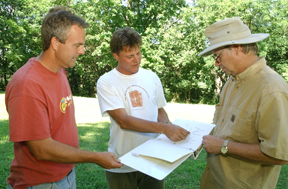 During the summer of 2003, David Nolan (ISAS-WIFS Coordinator) began working on an unsubsidized archaeological search for Fort Johnson and Cantonment Davis, two War of 1812-era military sites located in Warsaw, Illinois. He joined two local researchers who had spent years searching for these outposts, Joe Bartholomew of the Warsaw Historical Society and Steve Tieken of the Quincy-based North American Archaeological Institute. The work was made possible as a result of partnering with the city of Warsaw and their local historical society to generate interest and tourism as part of an ongoing effort to revitalize this picturesque 19th century river town.
During the summer of 2003, David Nolan (ISAS-WIFS Coordinator) began working on an unsubsidized archaeological search for Fort Johnson and Cantonment Davis, two War of 1812-era military sites located in Warsaw, Illinois. He joined two local researchers who had spent years searching for these outposts, Joe Bartholomew of the Warsaw Historical Society and Steve Tieken of the Quincy-based North American Archaeological Institute. The work was made possible as a result of partnering with the city of Warsaw and their local historical society to generate interest and tourism as part of an ongoing effort to revitalize this picturesque 19th century river town.
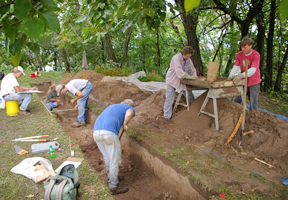 The investigation began as a weekends and evenings only survey to identify the location of these sites that relied upon the volunteer efforts of a small number of dedicated professionals and local individuals. However, it has since evolved into a formal research and excavation project directed and supported by the ISAS. A number of our staff and others from cooperating institutions have made in-kind donations of time and expertise over the years, including individuals from the USACOE-CERL (Michael Hargrave), the Iowa Office of the State Archaeologist (Bill Whittaker and Cindy Peterson), and Stratamorph GeoExploration, Inc. (Mike Kolb and Andy Jalbert).
The investigation began as a weekends and evenings only survey to identify the location of these sites that relied upon the volunteer efforts of a small number of dedicated professionals and local individuals. However, it has since evolved into a formal research and excavation project directed and supported by the ISAS. A number of our staff and others from cooperating institutions have made in-kind donations of time and expertise over the years, including individuals from the USACOE-CERL (Michael Hargrave), the Iowa Office of the State Archaeologist (Bill Whittaker and Cindy Peterson), and Stratamorph GeoExploration, Inc. (Mike Kolb and Andy Jalbert).
If you asked many Midwesterners, they would tell you that the War of 1812 was primarily fought along the Atlantic seaboard and Gulf Coast of the US, as well as the Great Lakes and adjoining portions of Canada. The role the upper Mississippi River valley played in this conflict is generally not well known, although this part of the western frontier figured prominently in the reasons for going to war with the British. Several key interruption points for travel along the river proved to be vital in the Americans struggle against the British and their native allies, including the area where Warsaw was ultimately founded.
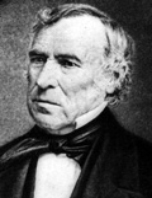 Brevet Major Zachary Taylor, the future United States president, established Fort Johnson in September 1814 to strategically command the mouth of the Des Moines River, a principal western artery situated at the foot of a series of rapids in the Mississippi. However, the fort was abandoned and destroyed after less than eight weeks existence because this remote location could not be provisioned through the upcoming winter. The following autumn, after the Treaty of Ghent ended the War of 1812, a second garrison of men was sent to establish a winter encampment, or cantonment, on the former site of Fort Johnson. Cantonment Davis was used as a winter staging ground for assembling the men and materials to build a fur trading facility at a nearby and more accessible location the following spring. This trading post came to be known as Fort Edwards and was used by the United States military and American Fur Trading Company for several decades prior to abandonment.
Brevet Major Zachary Taylor, the future United States president, established Fort Johnson in September 1814 to strategically command the mouth of the Des Moines River, a principal western artery situated at the foot of a series of rapids in the Mississippi. However, the fort was abandoned and destroyed after less than eight weeks existence because this remote location could not be provisioned through the upcoming winter. The following autumn, after the Treaty of Ghent ended the War of 1812, a second garrison of men was sent to establish a winter encampment, or cantonment, on the former site of Fort Johnson. Cantonment Davis was used as a winter staging ground for assembling the men and materials to build a fur trading facility at a nearby and more accessible location the following spring. This trading post came to be known as Fort Edwards and was used by the United States military and American Fur Trading Company for several decades prior to abandonment.
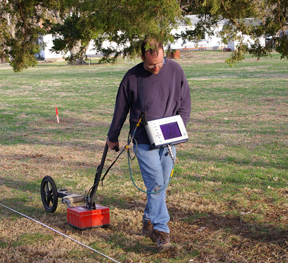 Although an obelisk now marks the location of Fort Edwards, the whereabouts of Fort Johnson and Cantonment Davis were largely unknown when the archaeological search began. Armed with several important documentary clues, the research team used a combination of auger test and several remote sensing survey techniques to explore a series of residential properties situated on the bluff top opposite the former mouth of the Des Moines. Somewhat serendipitously, the least heavily developed tract proved to be the location where the fort and cantonment ruins were ultimately discovered. These low impact methods produced a rather remarkable assemblage of military buttons and other period objects, as well as physical and geo-physical evidence for a number of associated cultural features.
Although an obelisk now marks the location of Fort Edwards, the whereabouts of Fort Johnson and Cantonment Davis were largely unknown when the archaeological search began. Armed with several important documentary clues, the research team used a combination of auger test and several remote sensing survey techniques to explore a series of residential properties situated on the bluff top opposite the former mouth of the Des Moines. Somewhat serendipitously, the least heavily developed tract proved to be the location where the fort and cantonment ruins were ultimately discovered. These low impact methods produced a rather remarkable assemblage of military buttons and other period objects, as well as physical and geo-physical evidence for a number of associated cultural features.
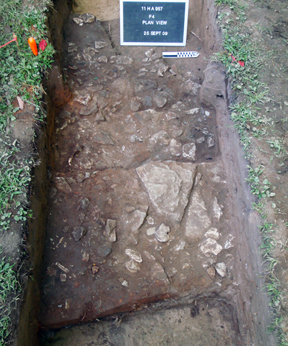 In 2009, ITARP/ISAS personnel returned to the site as part of their vacations to dig a series of hand units to illuminate the extent and function of the cultural features and deposits discovered during this earlier stage of probative work. All but one of the fifteen 1x2m hand units that were excavated produced evidence for War of 1812-era features. They include several broad shallow subterranean basins that presumably underlay log buildings, a heavily oxidized fireplace foundation comprised of laid limestone slabs, and a series of trenches and/or fortification ditches. Some of these features appear to correspond to structures and walls identified in the only period sketch of the fort layout, made by Captain James Callaway, who was stationed at Fort Johnson. We also uncovered stratigraphic evidence suggesting the subsided remains of the abandoned fort may have been reclaimed or filled with introduced sand during the subsequent Cantonment occupation in 1815.
In 2009, ITARP/ISAS personnel returned to the site as part of their vacations to dig a series of hand units to illuminate the extent and function of the cultural features and deposits discovered during this earlier stage of probative work. All but one of the fifteen 1x2m hand units that were excavated produced evidence for War of 1812-era features. They include several broad shallow subterranean basins that presumably underlay log buildings, a heavily oxidized fireplace foundation comprised of laid limestone slabs, and a series of trenches and/or fortification ditches. Some of these features appear to correspond to structures and walls identified in the only period sketch of the fort layout, made by Captain James Callaway, who was stationed at Fort Johnson. We also uncovered stratigraphic evidence suggesting the subsided remains of the abandoned fort may have been reclaimed or filled with introduced sand during the subsequent Cantonment occupation in 1815.
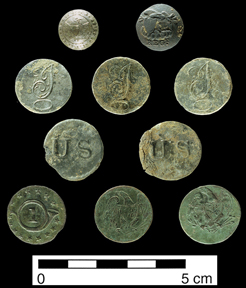 The excavation work also produced a surprisingly rich and varied artifact assemblage that is wholly consistent with military occupation dating between 1814 and 1816; no substantive quantities of later historic debris or more recent features have been noted. The artifacts include numerous military buttons, gunflints, and musket balls, as well as a small but surprising amount of domestic debris, such as animal bone, kitchen utensils, broken dishes, and parts of small glass containers. A few objects suggestive of interaction with Historic Indian groups, or perhaps their use of the site area, were also found, such as an iron arrowhead, a tinkling cone, and several glass trade beads.
The excavation work also produced a surprisingly rich and varied artifact assemblage that is wholly consistent with military occupation dating between 1814 and 1816; no substantive quantities of later historic debris or more recent features have been noted. The artifacts include numerous military buttons, gunflints, and musket balls, as well as a small but surprising amount of domestic debris, such as animal bone, kitchen utensils, broken dishes, and parts of small glass containers. A few objects suggestive of interaction with Historic Indian groups, or perhaps their use of the site area, were also found, such as an iron arrowhead, a tinkling cone, and several glass trade beads.
In short, the U of I/ISAS excavations demonstrate that the site has remarkable integrity and information potential. Relatively few military sites like it are available in the Midwest. As such, we consider it to represent a very significant resource for the people of Illinois, especially with the bicentennial of the War of 1812 fast approaching. Plans are currently underway to mark this celebration with a series of public lectures and targeted publications. Additional excavation of the site is also planned to increase our understanding of the fort layout, as well as the identity and association of its attendant facilities.
Further Reading
Excavations at the fort/cantonment have produced a plethora of information that has been published in several books and journals and has been presented at conferences throughout the United States.
Bartholomew, Joseph L., Steven L. Tieken, and David J. Nolan
2012 Searching for Fort Johnson, Hancock County, Illinois. Illinois Antiquity47(3):16–18.
Black Hawk
1882 Autobiography of Ma-Ka-Tai-Me-She-Kia-Kiak or Black Hawk. Continental Printing, St. Louis.
Ferguson, Gillum
2012 Illinois in the War of 1812. University of Illinois Press, Urbana.
Fishel, Richard L.
2012 War of 1812 Buttons from Fort Johnson and Cantonment Davis, Hancock County, Illinois. Midcontinental Journal of Archaeology 37:299–334.
2012 Establishing the Populations and Occupation Spans of Fort Johnson and Cantonment Davis, Hancock County, Illinois. Midcontinental Journal of Archaeology37:243–256.
Meese, William A.
1915 Credit Island, 1814–1914. Journal of the Illinois State Historical Society7(4):349–373.
Nolan, David J.
2009 Fort Johnson, Cantonment Davis, and Fort Edwards, 1814–1824. In Frontier Forts of Iowa: Indians, Traders, and Soldiers, 1682–1862, edited by William E. Whittaker, pp. 85–94. University of Iowa Press, Iowa City.
Nolan, David J., Robert N. Hickson, Steven R. Kuehn, and Mark C. Branstner
2012 Preliminary Examination of Archaeological Remains from Fort Johnson and Cantonment Davis. Midcontinental Journal of Archaeology 37:257–298.
Talbot, William L.
1968 Fort Edwards: Military Post and Fur Trade Center. In A History of Hancock County, Illinois: Illinois Sesquicentennial Edition, by R. M. Cochran et al., pp. 133–161. Hancock County Board of Supervisors, Carthage, Illinois.
Wesley, Edgar B.
1927 James Callaway in the War of 1812: Letters, Diary, and Rosters. Missouri Historical Society Collections 5(1):38–81.